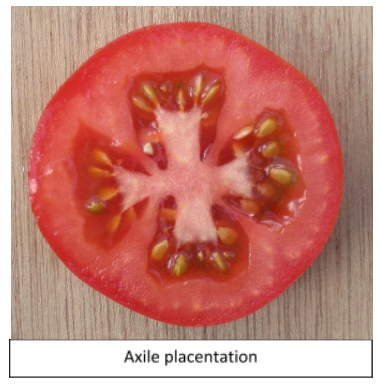
The arrangement of the ovules on the placenta developed from the central axis of the ovary is called
A. Parietal placentation
B. Axile placentation
C. Basal placentation
D. Marginal placentation
Answer
585.6k+ views
Hint: In plants, placenta refers to the surface of the carpel to which the ovules remain attached. Arrangement of ovules on the placenta developed from the central axis of the ovary gives rise to axial placenta.
Complete answer:
In Botany, placentation means the arrangement of placenta in the ovary of a flower. Now let us discuss different types of placentation mentioned above:
Parietal placentation: In this, the ovules are developed on the wall or as some outgrowths of the wall. Example- Mustard.
Axile placentation: Here, the ovules develop on the central axis of the ovary. The ovules develop at the angles where septa join the central placenta.
Example- Tomato.

Basal placentation: In this type of placentation, a single or a few ovules are developed at the base of an ovary. Example- Sunflower.
Marginal placentation: Here the ovules develop on the wall and along the ventral suture of a simple ovary.
Example- Pea
So, the correct answer is B. Axile placentation.
Note: When ovules arise on the central axis and the septa are absent, it is called free central aestivation. Example- Dianthus.
In Zoology, placentation is the formation of the placenta which is a structure in a woman’s uterus that transfers nutrients, water and respiratory gases from the maternal tissue to growing embryos.
Complete answer:
In Botany, placentation means the arrangement of placenta in the ovary of a flower. Now let us discuss different types of placentation mentioned above:
Parietal placentation: In this, the ovules are developed on the wall or as some outgrowths of the wall. Example- Mustard.
Axile placentation: Here, the ovules develop on the central axis of the ovary. The ovules develop at the angles where septa join the central placenta.
Example- Tomato.

Basal placentation: In this type of placentation, a single or a few ovules are developed at the base of an ovary. Example- Sunflower.
Marginal placentation: Here the ovules develop on the wall and along the ventral suture of a simple ovary.
Example- Pea
So, the correct answer is B. Axile placentation.
Note: When ovules arise on the central axis and the septa are absent, it is called free central aestivation. Example- Dianthus.
In Zoology, placentation is the formation of the placenta which is a structure in a woman’s uterus that transfers nutrients, water and respiratory gases from the maternal tissue to growing embryos.
Recently Updated Pages
The number of solutions in x in 02pi for which sqrt class 12 maths CBSE

Write any two methods of preparation of phenol Give class 12 chemistry CBSE

Differentiate between action potential and resting class 12 biology CBSE

Two plane mirrors arranged at right angles to each class 12 physics CBSE

Which of the following molecules is are chiral A I class 12 chemistry CBSE

Name different types of neurons and give one function class 12 biology CBSE

Trending doubts
Which are the Top 10 Largest Countries of the World?

What are the major means of transport Explain each class 12 social science CBSE

Draw a labelled sketch of the human eye class 12 physics CBSE

Differentiate between insitu conservation and exsitu class 12 biology CBSE

The computer jargonwwww stands for Aworld wide web class 12 physics CBSE

State the principle of an ac generator and explain class 12 physics CBSE




